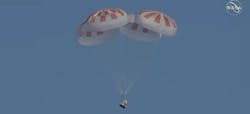SpaceX's Crew Dragon splashes down and marks the success of first NASA commercial crew flight test
“Today’s successful re-entry and recovery of the Crew Dragon capsule after its first mission to the International Space Station marked another important milestone in the future of human spaceflight,” said NASA Administrator Jim Bridenstine. “I want to once again congratulate the NASA and SpaceX teams on an incredible week. Our Commercial Crew Program is one step closer to launching American astronauts on American rockets from American soil. I am proud of the great work that has been done to get us to this point.”
Demonstration Mission-1 (Demo-1) was an uncrewed flight test designed to demonstrate a new commercial capability developed under NASA’s Commercial Crew Program. The mission began March 2, when the Crew Dragon launched from NASA’s Kennedy Space Center in Florida, and racked up a number of “firsts” in less than a week.
The mission was the first:
- Commercially-built and operated American crew spacecraft and rocket to launch from American soil on a mission to the space station.
- Commercially-built and operated American crew spacecraft to dock with the space station.
- Autonomous docking of a U.S. spacecraft to the International Space Station.
- Use of a new, global design standard for the adapters that connect the space station and Crew Dragon, and also will be used for the Orion spacecraft for NASA’s future mission to the Moon.
NASA and SpaceX teams gathered in the early morning hours at the company’s headquarters in Hawthorne, California, to follow the spacecraft’s return journey and ocean splashdown.
“If you just think about the enormity of this flight and all of the prep that went into it – getting the pad refurbished, getting the flight control room set up, getting the vehicle built, getting the Falcon 9 ready, all of the analysis and mission support that went into it – it’s just been a tremendous job. Our NASA and SpaceX teams worked seamlessly not only in the lead-up to the flight but in how we managed the flight,” said Steve Stich, deputy manager of NASA’s Commercial Crew Program.
Crew Dragon carried a passenger on this flight test – a lifelike test device named Ripley, which was outfitted with sensors to provide data about potential effects on humans traveling in the spacecraft. After SpaceX processes data from this mission, teams will begin refurbishing Crew Dragon for its next mission, an in-flight abort test targeted to take place this summer. Demo-2, the first crewed test flight, will carry NASA astronauts Bob Behnken and Doug Hurley on the spacecraft’s final flight to certify Crew Dragon for routine operational missions.
Ready to make a purchase? Search the Intelligent Aerospace Buyer's Guide for companies, new products, press releases, and videos
